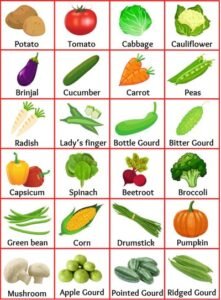
Understanding the names of vegetables in both English and Hindi can significantly enhance one’s culinary experience and knowledge. Vegetables are an essential part of our diet, providing vital nutrients and flavors that make our meals enjoyable and healthy. This guide aims to provide a detailed list of common vegetables, their English names, and their corresponding Hindi translations.
Common Vegetables and Their Names in English and Hindi
Leafy Greens
Leafy green vegetables are known for their rich nutrient content and are a staple in various cuisines around the world. Here are some common leafy greens:
- Spinach – पालक (Palak)
- Spinach is a versatile leafy green, packed with iron and vitamins. It is widely used in salads, smoothies, and cooked dishes.
- Lettuce – सलाद पत्ता (Salad Patta)
- Lettuce is a common ingredient in salads and sandwiches. Its crisp texture and mild flavor make it a popular choice.
- Kale – केल (Kale)
- Kale is a nutrient-dense vegetable, rich in vitamins K, A, and C. It is often used in salads, soups, and as a healthy snack in the form of kale chips.
- Fenugreek Leaves – मेथी (Methi)
- Fenugreek leaves are widely used in Indian cuisine, known for their distinctive flavor and health benefits, including aiding digestion and reducing inflammation.
Root Vegetables
Root vegetables grow underground and are known for their earthy flavors and high nutritional value. Here are some common root vegetables:
- Carrot – गाजर (Gajar)
- Carrots are a popular root vegetable, known for their vibrant orange color and sweet taste. They are rich in beta-carotene, fiber, and antioxidants.
- Potato – आलू (Aloo)
- Potatoes are a versatile vegetable used in a wide variety of dishes. They are a good source of carbohydrates and provide essential nutrients like potassium and vitamin C.
- Beetroot – चुकंदर (Chukandar)
- Beetroots are known for their deep red color and earthy flavor. They are rich in fiber, folate, and manganese.
- Radish – मूली (Mooli)
- Radishes are crisp and slightly spicy root vegetables. They are often used in salads, pickles, and as a garnish.
Cruciferous Vegetables
Cruciferous vegetables are known for their health benefits, including cancer-preventing properties. Here are some common cruciferous vegetables:
- Cauliflower – गोभी (Gobi)
- Cauliflower is a versatile vegetable that can be used in a variety of dishes, from curries to pizzas. It is rich in fiber, vitamins C and K, and antioxidants.
- Broccoli – ब्रोकोली (Broccoli)
- Broccoli is packed with vitamins, minerals, and bioactive compounds. It is often steamed, roasted, or used in stir-fries.
- Cabbage – पत्ता गोभी (Patta Gobi)
- Cabbage is a leafy green or purple vegetable used in salads, soups, and fermented foods like sauerkraut.
- Brussels Sprouts – ब्रेसल्स स्प्राउट्स (Brussels Sprouts)
- Brussels sprouts are small, leafy green buds that are rich in vitamins and fiber. They are often roasted or steamed.
Gourds and Melons
Gourds and melons are a diverse group of vegetables and fruits, often used in savory and sweet dishes. Here are some common types:
- Bottle Gourd – लौकी (Lauki)
- Bottle gourd is used in various Indian dishes and is known for its cooling properties and high water content.
- Bitter Gourd – करेला (Karela)
- Bitter gourd has a distinct bitter taste and is known for its medicinal properties, including blood sugar regulation.
- Pumpkin – कद्दू (Kaddu)
- Pumpkin is a versatile vegetable used in soups, pies, and savory dishes. It is rich in vitamins A and C, and fiber.
- Cucumber – खीरा (Kheera)
- Cucumbers are commonly used in salads and as a refreshing snack. They are hydrating and low in calories.
Legumes
Legumes are a vital source of protein and nutrients. Here are some common legumes:
- Green Beans – हरी फलियां (Hari Phaliyaan)
- Green beans are a popular vegetable that can be steamed, boiled, or stir-fried. They are rich in vitamins A, C, and K.
- Peas – मटर (Matar)
- Peas are sweet and tender legumes used in a variety of dishes, from soups to curries. They are high in fiber, protein, and vitamins.
- Chickpeas – चना (Chana)
- Chickpeas are used in various forms, including whole, as flour (besan), and in dishes like hummus. They are a good source of protein and fiber.
Nightshades
Nightshade vegetables are known for their unique flavors and are commonly used in many cuisines. Here are some examples:
- Tomato – टमाटर (Tamatar)
- Tomatoes are a staple in many dishes, providing a rich source of vitamins C and K, potassium, and antioxidants.
- Eggplant – बैंगन (Baingan)
- Eggplants are versatile and can be grilled, roasted, or used in stews and curries. They are rich in fiber and antioxidants.
- Bell Pepper – शिमला मिर्च (Shimla Mirch)
- Bell peppers come in various colors and are used in salads, stir-fries, and as a snack. They are rich in vitamins A and C.
- Chili Pepper – मिर्च (Mirch)
- Chili peppers add heat to dishes and are used fresh, dried, or as a powder. They are high in vitamins A, C, and capsaicin.

List of 100 vegetable names in english to hindi translations:
- Potato – आलू (Aloo)
- Tomato – टमाटर (Tamatar)
- Onion – प्याज (Pyaz)
- Carrot – गाजर (Gajar)
- Cabbage – पत्तागोभी (Patta Gobhi)
- Cauliflower – फूलगोभी (Phool Gobhi)
- Spinach – पालक (Palak)
- Radish – मूली (Mooli)
- Eggplant – बैंगन (Baingan)
- Peas – मटर (Matar)
- Ladyfinger/Okra – भिंडी (Bhindi)
- Pumpkin – कद्दू (Kaddu)
- Bottle Gourd – लौकी (Lauki)
- Bitter Gourd – करेला (Karela)
- Ridge Gourd – तोरई (Tori)
- Snake Gourd – चचेंड़ा (Chachenda)
- Drumstick – सहजन (Sahjan)
- Beetroot – चुकंदर (Chukandar)
- Corn – मक्का (Makki)
- Capsicum – शिमला मिर्च (Shimla Mirch)
- Broccoli – ब्रोकोली (Broccoli)
- Turnip – शलजम (Shaljam)
- Sweet Potato – शकरकंद (Shakarkand)
- Yam – जिमीकंद (Jimikand)
- Cucumber – खीरा (Kheera)
- Zucchini – तुरई (Turi)
- Celery – अजवाइन के पत्ते (Ajwain Ke Patte)
- Lettuce – सलाद पत्ता (Salad Patta)
- Asparagus – शतावरी (Shatavari)
- Artichoke – हाथी चक (Hathi Chak)
- Kale – करमसाग (Karamsaag)
- Swiss Chard – पालक चोलाई (Palak Cholai)
- Mustard Greens – सरसों का साग (Sarson Ka Saag)
- Collard Greens – कोलार्ड साग (Collard Saag)
- Fenugreek Leaves – मेथी (Methi)
- Dill – सोया (Soya)
- Purslane – कुलफा (Kulfa)
- Watercress – जलकुंभी (Jalkumbhi)
- Arugula – हरा सरसों (Hara Sarson)
- Endive – एन्डीव (Endive)
- Bok Choy – बोक चॉय (Bok Choy)
- Brussels Sprouts – ब्रसल्स स्प्राउट्स (Brussels Sprouts)
- Leek – हरा प्याज (Hara Pyaz)
- Scallion – हरा प्याज (Hara Pyaz)
- Shallot – छोटी प्याज (Choti Pyaz)
- Fennel – सौंफ (Saunf)
- Kohlrabi – गांठ गोभी (Ganth Gobhi)
- Parsnip – चिरायता (Chirayata)
- Radicchio – रेडिचियो (Radicchio)
- Jicama – शंख आलू (Shank Aloo)
- Taro – अरबी (Arbi)
- Lotus Root – कमल ककड़ी (Kamal Kakdi)
- Bamboo Shoot – बांस की कोपल (Bans Ki Kopal)
- Water Chestnut – सिंघाड़ा (Singhada)
- Indian Spinach – पौइ साग (Pau Saag)
- Amaranth Leaves – चौलाई (Chaulai)
- Sorrel – खटाई (Khatayi)
- Purslane – कुलफा (Kulfa)
- Pointed Gourd – परवल (Parwal)
- Ivy Gourd – कुंदरू (Kundru)
- Chayote – इस्कुस (Iskus)
- Fava Beans – बाकला (Bakla)
- Edamame – हरी सोयाबीन (Hari Soyabean)
- Broad Beans – सेम (Sem)
- Winged Beans – चौड़ी सेम (Chaudhi Sem)
- Cluster Beans – ग्वार फली (Gwar Fali)
- Green Beans – हरी फली (Hari Fali)
- Wax Gourd – पेठा (Petha)
- Ash Gourd – सफेद पेठा (Safed Petha)
- Spine Gourd – कंटोला (Kantola)
- Teasel Gourd – ककोड़ा (Kakoda)
- Snake Beans – बांस फली (Bans Fali)
- Chinese Cabbage – चीनी पत्तागोभी (Cheeni Patta Gobhi)
- Napa Cabbage – नापा पत्तागोभी (Napa Patta Gobhi)
- Moringa Leaves – सहजन के पत्ते (Sahjan Ke Patte)
- Curry Leaves – करी पत्ते (Curry Patte)
- Sorghum Leaves – ज्वार के पत्ते (Jwar Ke Patte)
- Banana Flower – केले का फूल (Kele Ka Phool)
- Green Chili – हरी मिर्च (Hari Mirch)
- Red Chili – लाल मिर्च (Lal Mirch)
- Ginger – अदरक (Adrak)
- Garlic – लहसुन (Lahsun)
- Turmeric – हल्दी (Haldi)
- Galangal – कुलंजन (Kulanjan)
- Lemongrass – नींबू घास (Nimbu Ghas)
- Mint – पुदीना (Pudina)
- Coriander – धनिया (Dhaniya)
- Parsley – अजमोद (Ajmod)
- Sage – सेज (Sage)
- Thyme – अजवायन के फूल (Ajwain Ke Phool)
- Rosemary – गुलमेंहदी (Gulmehandi)
- Basil – तुलसी (Tulsi)
- Oregano – अजवायन (Ajwain)
- Tarragon – खरसानी (Kharsani)
- Bay Leaf – तेज पत्ता (Tej Patta)
- Marjoram – मारेजोरम (Marjoram)
- Chives – चिव्स (Chives)
- Savoy Cabbage – सेवॉय पत्तागोभी (Savoy Patta Gobhi)
- Pak Choi – पक्क चोई (Pak Choi)
- Celery Root – अजवायन का मूल (Ajwain Ka Mool)

